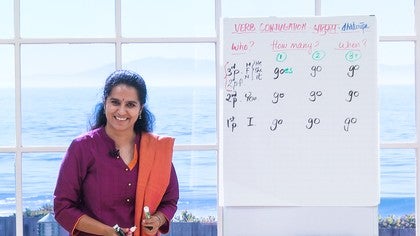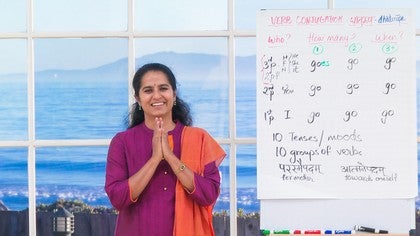Description
About This Video
Transcript
Read Full Transcript
Namaste dear friends. So thus far we've been looking at different words, at the gender of these different words, then we moved on to pronouns and then we are coming into the actors. So when we talk of pronouns, we also then start looking at actions or the verbs. If you remember when we talked about how language is built, words then combine with each other where you have nouns and pronouns that combine with verbs in order to make a sentence. So now in the next section, we will look at verbs and understand the basic framework of how these verbs are conjugated. Just like in the pronoun, we need to remember that simple tic takto grid. When we talk of verbs as well, a few questions come into mind. Who is performing the action? How many are performing the action? When are they performing the action? Right? So let's write that down. Who? How many? And when? Talking about who, as we have seen there are three different persons. There is the third person, third person. It can be masculine, feminine or neuter. Or we can have the, let's say the English it is he, she or it. Then we can talk of the second person or you. It can be formal or informal. But in the basic grid we had only the informal one. So second person and it is the you and then I can perform an action. So first person, first person and I. Just getting the basic grid in place, we have the singular so how many. So we can have one person performing the action. We can have two people performing the action or we can have many performing the action. Right? Now if we do the verb go in English, what happens? So the verb is to go, he, she, it, goes. Right? That's the root verb and to that you add goes. So just by looking at that ending, you know that it is a third person, he, she or it, going. In English language we do not have the dual case. So it would be they to go and they many go. So you see the verb doesn't undergo much of a change other than this third person singular part. Moving on to the second person we have you go, you too go, you many go. And then when talking of the first person I go, we too go, we all go. If you just look at that board there, one would not be surprised why English is becoming such a popular language world over. There's not really that much to remember but that's a trick mind you. That is a trick because when you say I go in the present tense, when I talk of the past tense it is I went. Now if you have a verb that is I eat, in the past tense it doesn't become I end, it is I ate. So there is not much of a system there. In Sanskrit there are many more changes that the verb would undergo but what is happening is that it is very mathematical. Once you learn the formula it becomes easy to apply for every other case in that category. That is our basic grid and what we have also seen in the pronouns is that we will take into consideration the you formal masculine and feminine and fortunately for us that comes into this category. So second person formal will behave just like the third person. So you formal it would technically be goals in Sanskrit. So we have seen how the second person formal also acts like the third person fortunately for us in Sanskrit. Actually it's very similar to the Spanish case where the word usted or the pronoun usted acts just like the third person or whatever. So there are similarities in the way different languages correspond to each other. Now we have looked at who is doing the action, we have looked at how many of them are doing the action. The third important question which is almost a three dimensional level to this discussion on verb conjugations is when is the person doing it. So there is the notion of which tense. So is it in the present tense, is it in the future. So is the person going now or tomorrow or in the past or in Sanskrit we also have something like the moods. We have ten tenses and moods. So I'll just write that out. We have ten tenses or moods. So tenses corresponds to the time exactly when. So is it today, tomorrow or the past. We have different numbers of present and future. One present, two future and three past tense there. And then in the mood we have things like ordering someone to do something or wishing that it was in a certain way etc.
So there are ten of them to remember. So it sounds like a lot but if we go through it step by step it will be easy. A last little note regarding the verbs in Sanskrit is that there are different groups of verbs. So in the French language also we have three groups of verbs which have the same kind of endings. If you know a verb with one kind of an ending and you understand how it is conjugated, any other verb in that category will function exactly in the same way or can be conjugated exactly in the same way. Similarly in Sanskrit we again have ten groups of verbs. There are ten of them but in most cases the ending of the verbs are the same. It's only the way in which the root transforms itself into the verb form that may change. So that is I'm just giving you the context. We will look at it step by step and we'll stick to things that are practical and most of the lessons that we will do initially would be in the present tense. In the present tense for the nine forms of the pronouns. Alright so look forward to seeing you more in the coming weeks where we will practice the verbs. We will practice about ten basic verbs to understand also how the verb to be acts. So stay tuned, practice, don't get disheartened but we'll get there.







You need to be a subscriber to post a comment.
Please Log In or Create an Account to start your free trial.